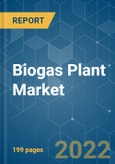The biogas plant installed capacity is expected to register a CAGR of 3.15% during the forecast period, 2022-2027, reaching a value of 21.5 GW by 2027 compared to 17.46 GW in 2020. The COVID-19 outbreak had a minor impact on the biogas plant market, with no major delay in projects. Projects like the Gandari biogas plant project in Nepal witnessed no major negative impact during the COVID-19 pandemic. With the increasing rate of pollution, many countries worldwide are putting emphasis on reducing carbon emissions. Using renewable sources, such as biogas, can help reduce the increasing carbon footprint and thereby reduce the average rate of the increasing temperature of the world. The biogas plants market is primarily driven by the supporting government policies and increasing share of biogas and biomethane blends. However, the biogas plant market can be obstructed by the increasing use of alternate renewable energy sources and high primary investment and installation costs.
The biogas plant market is fragmented. Some of the major players in the biogas plant market include Engie SA, Air Liquide SA, Ameresco Inc., Gasum Oy, and EnviTec Biogas AG.
This product will be delivered within 2 business days.
Key Highlights
- Small-scale digesters are expected to witness significant growth during the forecast period, mainly owing to the low capital requirement and demand in growing economies.
- Technological advancements and innovations in the biogas industry are also likely to serve as an opportunity for the market. Dendro Liquid Energy (DLE), Home Biogas, and BioBang are a few technologies that have attracted new players and driven the market further.
- As of 2021, Europe was the largest biogas producer owing to a large base of biogas facilities, with the majority situated in Germany and Italy.
Key Market Trends
Small-scale Digesters Expected to Witness Significant Growth
- The small-scale digestors are digesters with a capacity lesser than 250kW, and due to the lower investment and infrastructure requirement, their share in the global market is growing. Small-scale digesters play an essential role in rural areas of developing nations. Due to inaccessibility to modern technology, digesters are most often used in stoves for cooking and heating purposes.
- Small-scale digesters provide greener energy and reduce the dependency on hydrocarbon fuels, such as natural gas or liquefied petroleum gas. Small-scale digesters also offer food security to economically backward populations.
- Although the share of small-scale digesters was around 24% in 2020, this share is expected to increase gradually during the forecast period. Small-scale digesters are usually prominent in Asian countries like India, Thailand, and China. Gradually the share in the European countries and the United States has also increased. According to the United States Environmental Protection Agency, as of September 2021, more than 317 anaerobic digester projects were operating on livestock farms in the United States.
- With government initiatives, usage of biogas for domestic purposes is expected to increase during the forecast period. For instance, the Government of India launched a policy named National Biogas and Manure Management Programme (NBMMP), which provides subsidies to set up biogas plants for domestic uses, mainly for rural and semi-urban/households.
- Overall, low capital investment requirements, rising demand in growing economies, and supporting government initiatives are expected to propel the growth of the small-scale digester segment during the forecast period.
Europe is Expected to Dominate the Market
- Europe is dominating the biogas plant market with the maximum volume of biogas production. As of 2020, the region was the largest biogas producer, with around 18,943 biogas plants.
- According to the European Biogas Association (EBA), biogas production in Europe is expected to reach 98 billion cubic meters (bcm) of biomethane by 2050, a 4,800% increase in current levels of production.
- The plan to increase biogas production is expected to attract investments to build biogas production facilities, which is expected to promote the growth of biogas plants in the near future.
- Germany has been the frontier of biogas plant development in the region. For the past years, it has been developing a new biogas infrastructure that can provide additional support to the growing biogas market. For instance, in June 2020, a collaboration of industry partners in the biomethane industry and the Deutsche Engergie-Agentur built a new biogas pipeline that can bundle the raw biogas supplies up to 48 biogas plants across Germany.
- Moreover, in June 2021, Nordsol and DBG Bio Energy BV signed an agreement to collaborate on the development of a new bio-LNG installation in the Netherlands. DBG Bio Energy BV is using a patented process to convert cellulose-containing industrial waste streams into biogas. Nordsols iLNG technology can process this biogas into bio-LNG in an energy-efficient way. This technology can also provide additional green value through the capture and liquefaction of bioCO2 from the biogas to replace fossil CO2.
- Therefore, owing to the above points, increased investment activity, and alignment with the green policies of the region, Europe is expected to witness significant growth in the biogas plant market during the forecast period.
Competitive Landscape
The biogas plant market is fragmented. Some of the major players in the biogas plant market include Engie SA, Air Liquide SA, Ameresco Inc., Gasum Oy, and EnviTec Biogas AG.
Additional Benefits:
- The market estimate (ME) sheet in Excel format
- 3 months of analyst support
This product will be delivered within 2 business days.
Table of Contents
1 INTRODUCTION
4 MARKET OVERVIEW
5 MARKET SEGMENTATION
6 COMPETITIVE LANDSCAPE
Companies Mentioned (Partial List)
A selection of companies mentioned in this report includes, but is not limited to:
- Engie SA
- Air Liquide SA
- Scandinavian Biogas
- Gasum Oy
- Ameresco
- A2A SpA
- AB Holding SpA (Gruppo AB)
- EnviTec Biogas AG
- BTS Biogas SRL/GmbH
- FWE GmbH
- Agraferm GmbH
Methodology

LOADING...










